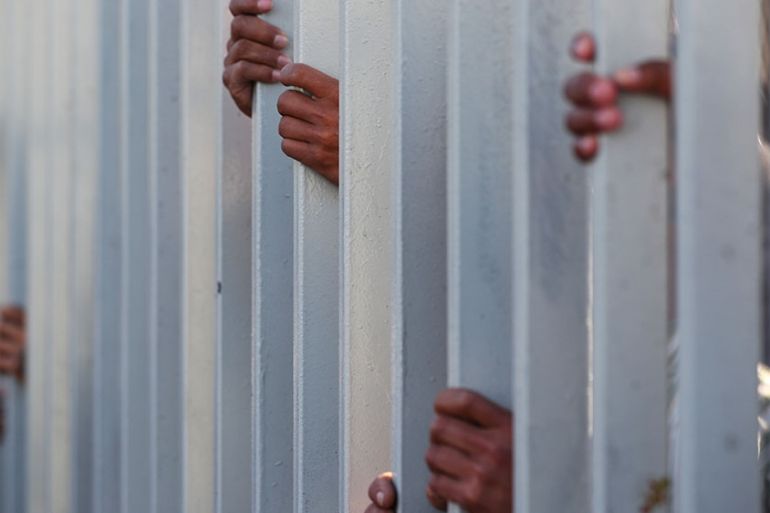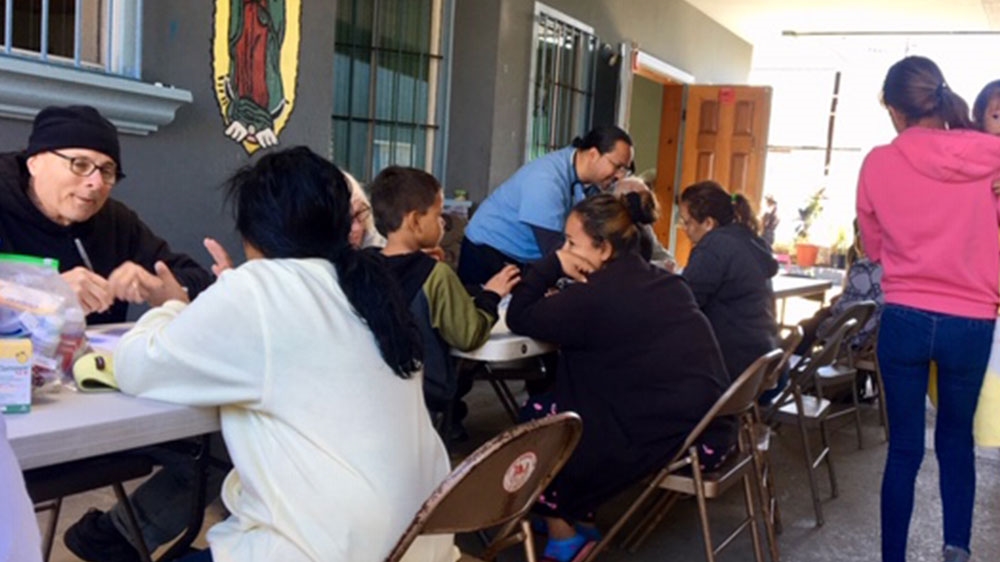Surviving migrant shelters, US detention with a mental illness
Healthcare workers say many asylum seekers suffer from mental illnesses but most go untreated due to limited resources.

Tijuana, Mexico – Twenty-eight seconds may have saved Miguel’s life.
The 32-year-old was brought to the United States from Mexico as a child. He lived without documents in the country for more than two decades before he was detained by US immigration authorities last year.
Keep reading
list of 4 itemsIn India’s richest state, exam scams kill escape from farm crisis
Displaced 12-year-old boy becomes Gaza’s youngest medic
Why are so many young Americans suffering from mental distress?
Miguel* said he spent a month in a detention centre in Los Angeles, California, in conditions he described as “hell”.
“You’re inside that cell for 23 hours [a day],” he told Al Jazeera.
“I saw people receiving medication for things they don’t have, they don’t need. They start hearing voices, they start seeing things, and it’s because they’re going through a lot, and they don’t receive any therapy,” he added.
He said he was eventually given a choice: Stay in detention to fight his case in the US, or be deported to Mexico. Miguel chose the latter – officially – but in reality, he had a third option in mind.
“After being through all that, my first thought was to commit suicide,” Miguel said. “Why? At first it was because [of what happened at the detention centre] … You get to the point of no return.”
Miguel said border patrol agents drove him and a group of migrants to the border, but it had closed 28 seconds before they arrived. They were forced to stay in the detention centre one more night and Miguel reconsidered suicide. The next morning he went to a shelter in Tijuana instead of to the nearest bridge.
“When I got here, I was afraid, because it’s a brand new country,” Miguel said. “To be honest, in Mexico, I feel like an immigrant. I don’t feel Mexican because I didn’t grow up here … I really feel weird here. But I have to wait.”
Miguel is now one of more than 13,000 individuals waiting to enter the US along the Mexican border. Some live in detention centres, crowded shelters and makeshift camps. Many have walked thousands of kilometres to get there, sustaining physical injuries from their journeys. Others have been recently deported after living years in the US without documents.
The gruelling journeys, treatment along the way and rhetoric in the US have created conditions for asylum seekers and migrants to develop the mental illnesses that one may expect: PTSD, depression and suicidal ideation. But healthcare professionals say with limited resources and access, and as the number of migrants at the border continues to swell, many go untreated.
Treatment is spotty – at best
Miguel spent more than 20 years living in the US and was attending community college and pursuing citizenship when he was detained. He said he now suffers from anxiety disorders, PTSD, depression and anxiety as he waits in a shelter while the lawyers he has hired in the US fight to get him a visa.
At the Casa del Migrante shelter in Tijuana, Miguel was able to access mental health treatment.
“They’re giving me therapy now,” he said. “It’s better.”
But for many, treatment is hard to come by, especially when they are regularly moving shelters or areas of the city.
Abigail Hitchen, a psychologist from across the border in San Diego, California, visits Tijuana to work with the San Diego Border Dreamers, an organisation providing migrants with medical care. The group is in the process of establishing a permanent location in Tijuana, but for now, they operate as a mobile clinic, with volunteers travelling by car to get from one location to the next.
Hitchen said treatment in border shelters is made more difficult by the erratic nature of the living conditions there. Doctors can’t responsibly prescribe medications such as antidepressants because they can’t monitor any side effects or guarantee long-term use.

Some asylum seekers may be moved to a different shelter, approved for entry to the US, or decide to cross the border irregularly on their own, making it unlikely for Hitchen or other doctors to be able to follow up with them. Without being able to obtain prescription refills or maintain ongoing care, it is likely many individuals would be forced to stop taking their medications altogether.
Katrina Cisneros, a licensed independent clinical social worker at the University of Minnesota, has also worked along the border to provide mental health treatment to migrants. She has worked with women and children through Border Dreamers and explained the challenges of working with individuals in the shelter system.
“There’s no physical or psychological safety, because they’re in the shelters in this holding pattern waiting to seek asylum,” Cisneros said. “There’s a transient nature to the environment. If they get care this Saturday, who’s going to be there next Saturday? And can we guarantee that the person will even be there?”
Surviving the wait
For many, it is the wait in the shelters in Mexico that only exacerbates the depression and trauma they experienced during their gruelling journeys to the US-Mexico border.
Elizabeth* was forced to flee Ghana in 2018 after a former girlfriend told police Elizabeth was bisexual. Because any non-heterosexual relationships are illegal in Ghana, Elizabeth feared she would be detained and imprisoned. She was one-month pregnant at the time and already the mother of a young daughter, who she had to leave behind in order to escape quickly. She first flew to South Africa, then to Ecuador, from where she continued her journey by foot, climbing mountains and hiking through jungles. She said she nearly drowned in a river, and while in the Colombian jungle, she thought death may be better than going on. Her journey took four months, including six days spent in a Mexican detention centre.
“It was terrible,” Elizabeth said of the detention centre. “But I survived.”
At five months pregnant, she made it to a crowded shelter for women and children in Tijuana. She said she experiences depression and anxiety while she waits to get to the US. If she’s granted asylum, she hopes to continue her work as a licensed midwife, as she was in Ghana.
“Right now I’m becoming a single mother. I don’t know what to do,” Elizabeth told Al Jazeera. “I’m thinking about this pregnancy alone and where my baby is [in Ghana]. Sometimes I feel like ending [my life]…I want to go to an English-speaking country, where there’s less crime, where I can have peace.”
‘Trauma doesn’t go away once you cross the border’
For those who do cross the border irregularly, Hitchen fears the conditions in US immigration detention creates conditions for those living with mental illness to only get worse.
A recent report by the Project on Government Oversight found Immigration and Customs Enforcement (ICE) regularly treats migrants and deportees with mental illness by placing them in solitary confinement for extended periods.
The organisation reviewed 6,559 records from 2016 to May 2018 and found 40 percent of those who were placed in solitary confinement by ICE had mental illnesses. The report is the first to cover detainment records that span the majority of the Trump administration.
The trauma isn't going to end necessarily when they cross the border.
More than 60 percent of those held in solitary confinement were kept there for more than 15 days.
In an email to Al Jazeera, ICE said it is “committed to ensuring the welfare of all those in the agency’s custody, including providing access to necessary and appropriate medical care”.
The agency added that it spends more than $250m a year on healthcare services provided to detainees.
An internal government watchdog released a report on Wednesday, detailing the trauma suffered by children separated from their parents under Trump’s “zero tolerance” policy. The report found that children suffered from post-traumatic stress and other serious mental health issues as a result of the practice, which was officially ended in June 2018.
“The trauma isn’t going to end necessarily when they cross the border,” Hitchen said. “There’s abuse in the detention centres, and [migrants] don’t know where to go.”
Treating unaccompanied minors
Back in Tijuana, Border Dreamers can see more than 200 patients at nine shelters in one day with a team of 16 medical professionals and an additional 24 support volunteers working across the city. The organisation treats the majority of those individuals for physical injuries and illnesses, while Hitchen works specifically with those in need of mental healthcare.
Hitchen is often the only mental health professional on the team that day and on many weekends, saw more than a dozen patients in less than eight hours, including teenagers at a shelter for unaccompanied minors.
Hitchen said the unaccompanied minors and adult asylum seekers alike are experiencing “What it’s like to be between worlds right now”.
One 15-year-old travelled nearly 5,000 kilometres alone from Honduras after the teen said gang members threatened to assault her as part of an extortion campaign against her family’s business.
The teen spent her nights lying awake to avoid the nightmares she has from her life in Honduras, too scared to walk down the streets outside the shelter.
Nightmares, loss of sleep, depression and anxiety are all common among the migrant populations waiting in shelters, Cisneros said.
“You have a large group of people who find themselves in very vulnerable positions. They’re primarily seeking asylum; they’re seeking refuge; they’re fleeing for their lives,” Cisneros said. “They talk about how dark the night gets.”
*Name has been changed to protect the individual’s identity.